-

部编版语文九年级上册《我爱这土地》教案
目标导学四:赏析作品,把握诗歌艺术特色1.这首诗在结构上共分两节,请简要说说两节诗歌各有什么特点及它们之间的内在联系。明确:诗的第一节是从虚拟的视角,即从鸟儿的视角去想象,去表现鸟儿对土地的忠诚与挚爱,显得形象含蓄;第二节却换成实写的视角,即从作者自我的视角去实写自己“常含泪水的眼睛”,倾诉自己对土地的“深沉”之爱,是直抒胸臆。这样,虚境和实境的结合与对应,构筑了全诗内在完整的艺术空间;结果与原因的关联与对照,又构成了支撑全诗的内在逻辑结构。此外,从手法特点上看,第一节用的是比,是想象的境界;第二节则是直抒胸臆的写实。全诗由前面蒙太奇镜头式的画面暗示转到了后面作者的直接指点,以一个强有力的情感抒发结束了全篇,从而把注意力引到一个浓郁的情感氛围中,再一次感受到作者对土地的忠贞与挚爱。
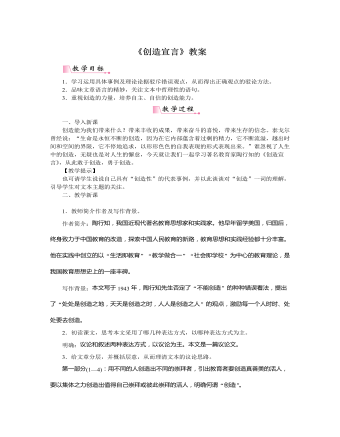
部编版语文九年级上册《创造宣言》教案
1.学习运用具体事例及理论论据驳斥错误观点,从而得出正确观点的驳论方法。2.品味文章语言的精妙,关注文本中哲理性的语句。3.重视创造的力量,培养自主、自信的创造能力。一、导入新课创造能为我们带来什么?带来丰收的成果,带来奋斗的喜悦,带来生存的信念。泰戈尔曾经说:“生命是永恒不断的创造,因为在它内部蕴含着过剩的精力,它不断流溢,越出时间和空间的界限,它不停地追求,以形形色色的自我表现的形式表现出来。”谁忽视了人生中的创造,无疑也是对人生的懈怠,今天就让我们一起学习著名教育家陶行知的《创造宣言》,从此敢于创造,勇于创造。【教学提示】也可请学生说说自己具有“创造性”的代表事例,并以此谈谈对“创造”一词的理解,引导学生对文本主题的关注。二、教学新课目标导学一:初读课文,整体感知1.教师简介作者及写作背景。
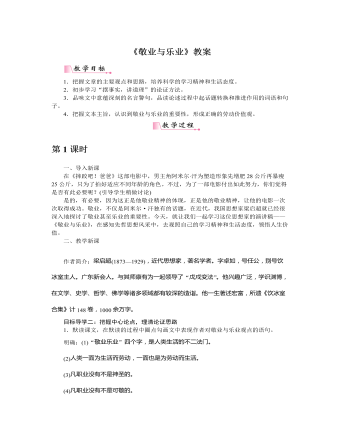
部编版语文九年级上册《敬业与乐业》教案
一、导入新课在《摔跤吧!爸爸》这部电影中,男主角阿米尔·汗为塑造形象先增肥28公斤再暴瘦25公斤,只为了拍好适应不同年龄的角色。不过,为了一部电影付出如此努力,你们觉得是否有此必要呢?(引导学生稍做讨论)是的,有必要,因为这正是他敬业精神的体现,正是他的敬业精神,让他的电影一次次取得成功。敬业,不仅是阿米尔·汗独有的话题,在近代,我国思想家梁启超就已经很深入地探讨了敬业甚至乐业的重要性。今天,就让我们一起学习这位思想家的演讲稿——《敬业与乐业》,在感知先哲思想风采中,去观照自己的学习精神和生活态度,领悟人生价值。二、教学新课目标导学一:认识作者作者简介:梁启超(1873—1929),近代思想家,著名学者。字卓如,号任公,别号饮冰室主人。广东新会人。与其师康有为一起领导了“戊戌变法”。他兴趣广泛,学识渊博,在文学、史学、哲学、佛学等诸多领域都有较深的造诣。他一生著述宏富,所遗《饮冰室合集》计148卷,1000余万字。
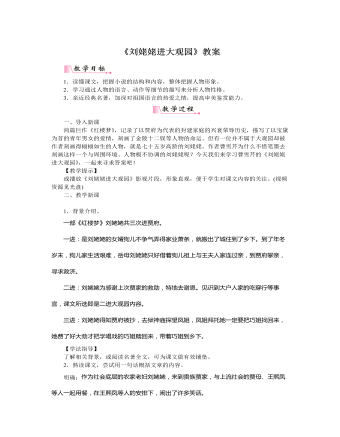
部编版语文九年级上册《刘姥姥进大观园》教案
2.这篇课文细致地描写了各具情态的笑,给人留下了难忘的印象。请说说主要人物的笑有什么不同,反映了他们怎样的性格特点。明确:凤姐、鸳鸯的笑而不露,反映出她们善于计谋,爱耍小手段、取笑、捉弄人的性格特点;史湘云“掌不住,一口茶都喷出来”,反映出她的率真、爽朗、不受拘束的性格;林黛玉“笑岔了气,伏着桌子只叫‘嗳哟!’”,可见她的笑是极力控制,反映出她含蓄、有教养而又谨慎的性格;宝玉笑时钻到贾母的怀里,反映出他的天真、孩子气,也写出了贾母爱孙之心;探春手里的“茶碗都合在迎春身上”,反映了她率真、爽朗、不受拘束的性格特点,也可以看出她要强的个性;惜春笑得肚子疼,让奶母给揉肠子,反映出她娇气、孩子气;“王夫人笑的用手指着凤姐儿,只说不出话来”,写出王夫人已知道是凤姐导演的,但又不便张扬的心理,也保持了雍容与尊贵。
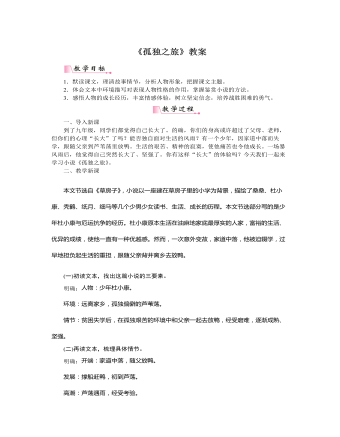
部编版语文九年级上册《孤独之旅》教案
一、导入新课到了九年级,同学们都觉得自己长大了。的确,你们的身高或许超过了父母、老师,但你们的心理“长大”了吗?能否独自面对生活的风雨?有一个少年,因家道中落而失学,跟随父亲到芦苇荡里放鸭。生活的艰苦、精神的寂寞,使他痛苦也令他成长。一场暴风雨后,他觉得自己突然长大了、坚强了。你有这样“长大”的体验吗?今天我们一起来学习小说《孤独之旅》。二、教学新课目标导学一:背景资料本文节选自《草房子》,小说以一座建在草房子里的小学为背景,描绘了桑桑、杜小康、秃鹤、纸月、细马等几个少男少女读书、生活、成长的历程。本文节选部分写的是少年杜小康与厄运抗争的经历。杜小康原本生活在油麻地家底最厚实的人家,富裕的生活、优异的成绩,使他一直有一种优越感。然而,一次意外变故,家道中落,他被迫辍学,过早地担负起生活的重担,跟随父亲背井离乡去放鸭。
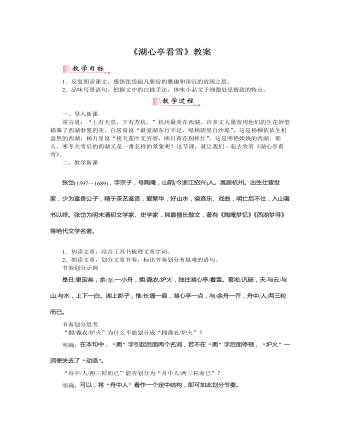
部编版语文九年级上册《湖心亭看雪》教案
一、导入新课常言道:“上有天堂,下有苏杭。”杭州最美在西湖。许多文人墨客用他们的生花妙笔描摹了西湖春夏的美。白居易说“最爱湖东行不足,绿杨阴里白沙堤”,这是杨柳依依生机盎然的西湖;杨万里说“接天莲叶无穷碧,映日荷花别样红”,这是明艳妖娆的西湖。那么,寒冬大雪后的西湖又是一番怎样的景象呢?这节课,就让我们一起去欣赏《湖心亭看雪》。二、教学新课目标导学一:认识作者,了解作品张岱(1597—1689),字宗子,号陶庵,山阴(今浙江绍兴)人。寓居杭州。出生仕宦世家,少为富贵公子,精于茶艺鉴赏,爱繁华,好山水,晓音乐、戏曲,明亡后不仕,入山著书以终。张岱为明末清初文学家、史学家,其最擅长散文,著有《陶庵梦忆》《西湖梦寻》等绝代文学名著。目标导学二:朗读训练,通文顺字1.初读文章,结合工具书梳理文章字词。2.朗读文章,划分文章节奏,标出节奏划分有疑难的语句。节奏划分示例
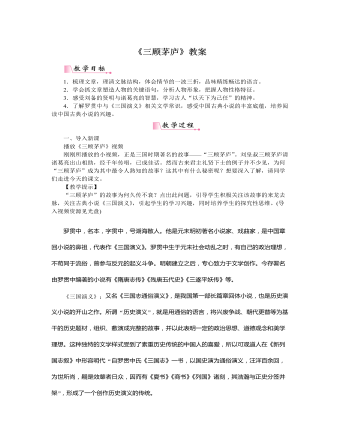
部编版语文九年级上册《三顾茅庐》教案
【教学提示】引导学生分析把握人物的性格特征,在理清人物性格之后,可分角色扮演,还原三顾茅庐情景。角色表演时注意引导学生表现出角色的独特性格。目标导学四:精彩段落研读,解说“隆中对”内容精读“又立了一个时辰,孔明才醒……以成鼎足之势,然后可图中原也”,完成以下问题。1.请你结合全文内容,说一说你对诸葛亮所吟的四句诗的理解。明确:“大梦谁先觉?平生我自知”暗示诸葛亮“未出茅庐,已知三分天下”的雄才大略,“草堂春睡足,窗外日迟迟”写出了诸葛亮淡泊名利。这四句诗为下文故事情节的发展做了铺垫。2.为什么作者安排通过刘备的视线写诸葛亮的相貌?相貌描写片段:玄德见孔明身长八尺,面如冠玉,头戴纶巾,身披鹤氅,飘飘然有神仙之概。明确:一方面写出诸葛亮气宇轩昂,神异不凡,另一方面更加坚定了刘备对诸葛亮的信任,确实有将相之才,又为下文的一再邀请做了铺垫。
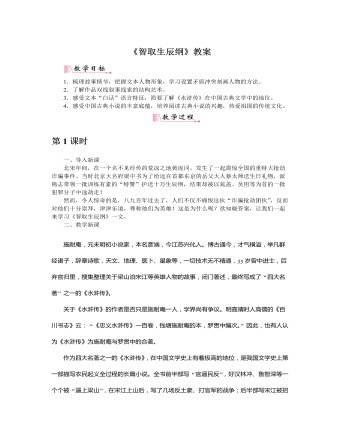
部编版语文九年级上册《智取生辰纲》教案
目标导学二:分析人物形象与环境,探究杨志“失纲”原因1.文中用了大量的笔墨来刻画杨志这一人物,结合文中关于杨志的言行,说说他具有怎样的性格特征,这与他丢失生辰纲有怎样的关系。明确:(1)对路途的凶险有着清醒的认识,根据不同的地形,更改行路的时间。开始是趁凉行路,后来到了“人家渐少,行客又稀”的山路地带,为安全起见,改为“辰牌起身,申时便歇”,天正热时赶路,而且不允许大家在黄泥冈的松林里休息。为防止遭劫,兵士要买酒喝,他又千方百计阻拦。这都充分体现了杨志的精明、小心谨慎的性格特征。(2)杨志对待下属,“轻则痛骂,重则藤条便打”,军汉们“雨汗通流”,苦不堪言,怨声载道。这又体现了杨志粗暴蛮横、刚愎自用的性格特征。杨志的精明谨慎原本不应该产生“失纲”的结果,但是正是因为这份谨慎,才促使他将他的粗暴蛮横、刚愎自用发挥到了极点,以至于内部失和,最后军汉们非要在黄泥冈停住,并买酒中计,从而导致了他的“失纲”。
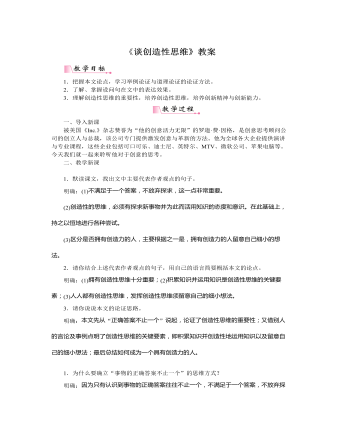
部编版语文九年级上册《谈创造性思维》教案
一、导入新课被美国《Inc.》杂志赞誉为“他的创意活力无限”的罗迦·费·因格,是创意思考顾问公司的创立人与总裁,该公司专门提供激发创意与革新的方法。他为全球各大企业提供演讲与专业课程,这些企业包括可口可乐、迪士尼、英特尔、MTV、微软公司、苹果电脑等。今天我们就一起来聆听他对于创意的思考。二、教学新课目标导学一:把握论点,理清论证思路1.默读课文,找出文中主要代表作者观点的句子。明确:(1)不满足于一个答案,不放弃探求,这一点非常重要。(2)创造性的思维,必须有探求新事物并为此而活用知识的态度和意识。在此基础上,持之以恒地进行各种尝试。(3)区分是否拥有创造力的人,主要根据之一是,拥有创造力的人留意自己细小的想法。2.请你结合上述代表作者观点的句子,用自己的语言简要概括本文的论点。明确:(1)拥有创造性思维十分重要;(2)积累知识并运用知识是创造性思维的关键要素;(3)人人都有创造性思维,发挥创造性思维须留意自己的细小想法。
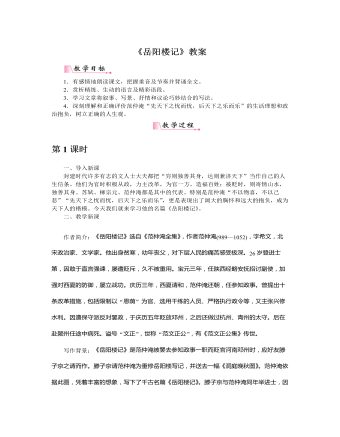
部编版语文九年级上册《岳阳楼记》教案
一、教学新课目标导学一:精读全文,把握文章主旨1.文章第一段写重修岳阳楼的背景,这背景是什么?说明了什么?明确:在“政通人和,百废具兴”的基础上“重修岳阳楼”,这说明滕子京在谪守的逆境中,仍不以己悲,把政事治理得井井有条。由此可见作者欣赏他的阔大胸怀,与一般的“迁客”不同。2.“予观夫巴陵胜状,在洞庭一湖”,作者写出了从岳阳楼看洞庭湖的哪些特点?明确:(1)气势非凡:“衔远山,吞长江”;(2)宽阔无边:“浩浩汤汤,横无际涯”;(3)湖光山色:“朝晖夕阴,气象万千”。3.作者为什么忽然写“前人之述备矣”,从写景中跳出来写人?明确:“前人之述备矣”一句承前启后,并回应前文“唐贤今人诗赋”一语。这句话既是谦虚,也暗含转机,经“然则”一转,引出新的意境,由单纯写景,到以情景交融的笔法来写“迁客骚人”的“览物之情”,从而引出全文的主体。

部编版语文九年级上册《醉翁亭记》教案
一、导入新课范仲淹因参与改革被贬,于庆历六年写下《岳阳楼记》,寄托自己“先天下之忧而忧,后天下之乐而乐”的政治理想。实际上,这次改革,受到贬谪的除了范仲淹和滕子京之外,还有范仲淹改革的另一位支持者——北宋大文学家、史学家欧阳修。他于庆历五年被贬谪到滁州,也就是今天的安徽省滁州市。也是在此期间,欧阳修在滁州留下了不逊于《岳阳楼记》的千古名篇——《醉翁亭记》。接下来就让我们一起来学习这篇课文吧!【教学提示】结合前文教学,有利于学生把握本文写作背景,进而加深学生对作品含义的理解。二、教学新课目标导学一:认识作者,了解作品背景作者简介:欧阳修(1007—1072),字永叔,自号醉翁,晚年又号“六一居士”。吉州永丰(今属江西)人,因吉州原属庐陵郡,因此他又以“庐陵欧阳修”自居。谥号文忠,世称欧阳文忠公。北宋政治家、文学家、史学家,与韩愈、柳宗元、王安石、苏洵、苏轼、苏辙、曾巩合称“唐宋八大家”。后人又将其与韩愈、柳宗元和苏轼合称“千古文章四大家”。

人教版新目标初中英语八年级下册It’s a nice day, isn’t it教案2篇
"Hello! Welcome to English class! Introduce yourself. Meet your new classmates." That's what the teacher says. What do you say? "Oh no!" It can be difficult talking to new people. But it can be fun, and you can make friends. How do you do it? Make small talk. Small talk is polite conversation. "Wang Nan is a great pingpang player, isn't she?" "I'd love to meet her, wouldn't you?" "It's been raining a lot, hasn't it?" Tag questions are a form of polite speech. To make small talk successfully, you should know how to make them. You should also know what topics to talk about. Try to learn this unit carefully. The next time you're in English class, you'll find out. Making small talk's easy, isn't it? (“你好!欢迎你!请做一下自我介绍。认识一下你的新同学。”通常在课上老师会这样说。你会说什么呢?“噢,不!”与陌生人谈话太困难了。但是这也很有意思,并且你还能交到朋友。你该怎么做呢?闲聊。闲聊指得是礼貌的对话。“王楠是一个很棒的乒乓球运动员,不是吗?”“我希望自己能认识她,你呢?“今年的雨水很多,不是吗?”反意疑问句是一种礼貌用语。为了使得谈话成功,你应该知道怎样去进行闲聊。你还应该知道与不同的人该谈论什么样的话题。认真的学习这个单元吧,下次在英语课上,你会发现与大家展开谈话是一件很容易的事情,不信我们来试试。)

人教版新目标初中英语八年级下册How long have you been collecting shells教案2篇
Step Ⅱ Show the new words on the screen and teach the new words. Read the new words to students and ask them to repeat.Step Ⅲ 3aThis activity introduces new vocabulary and provides reading practice using the target language.In this activity first look at the four pictures.T: What can you see in the pictures?Ss: Four snow globes.T: Right. There are four snow globes in the pictures. And what are they?Ss: They are a monster, two polar bears, two penguins and a birthday cake.Write these words on the blackboard: snow globe; monster; polar bear; penguin and birthday cake. Read them to the class and ask students to repeat each one. Make sure students understand each word.Use a computer to show the E-mail message on the screen and read the message to students.Get students to read the e-mail on their own, and then draw lines connecting each snow globe and its description.Correct the answers.AnswersA line should connect each snow globe picture with the words that describe it in the letter.Step Ⅳ 3bThis activity provides writing practice using the target language.First review Activity 2a on Page 47.Then ask students to complete the message according to Activity 2a.Some partial sentences are given to students. Write about one person's collection.When students work, walk around the room checking the progress and offering help as needed.When they finish, ask some students to read their messages to the class.

人教版新目标初中英语八年级下册Why don’t you get her a scarf教案
教师带领学生复习有关描述宠物的词汇,采用教师提问学生回答的方进行。如:T:What animals do you think would be good pets?What animals do you think would be bad pets?What do you think are good animals for a six-year-old child?然后学生进行 pairwork 练习。Task two: 师生互动,学习探究 1、播放3a部分的录音,引导学生一边听录音,一边跟读。2、通过听录音学生回答以下问题:Why do you think pot-bellied pigs are popular?What are the advantages and disadvantages of keeping such a pet?教师对学生的回答进行及时点评。3.学习范文,学习重点短语,为下步的模仿写作提供语言素材。T :1. )Have you ever kept a pig as a pet?Do you like pigs? St.:No.…Why don’t you like to keep a pig? St: No.They’re too dirty and lazy(Do you know in some foreign countries like Hollyland, Australia,pigs are the most popular pet.there’s a kind of pig.(图)it has an interesting name? it ‘s called a pot-bellied pig.) Now,let’s learn an article about this kind of interesting pet.2.)play the tapeSt.:Listen and repeat3.)show some Qs on computer(本子St.: read silently,then answerthe Qs(本子)4.)Ask ss. Close book and retell this passage.(what is a pot-bellied pig? Is it a good or bad pet? ) St.: retell it to each other“A pot –bellied pig is a popular pet now…”5.read the article together.St.:.practice reading

人教版新目标初中英语七年级下册How was your weekend教案2篇
Teaching Goal:1. General aims:Talk about recent past events2. Particular aims:A. Language Focus.Talk about recent past events and think of the past events.B. Language goalsHow was….?It was …What did …do over the weekend?C. Language structures:(1). How was your weekend? I was great. Pay attention to no form.(2). What did you do over the weekend? I played soccer. We went to the beach.D. Useful words and phrases:Words: was, did, went, beach, over, project, test, wasn’t, false, number, geography, spend, week, most, mixture, their, had, little, cook, read, saw, change, everyone, sit, sat, no, anythingPhrases: did one’s homework, played soccer, cleaned my room, went to the beach, played tennis, went to the movies, on Saturday morning, over the weekend, cook … for, what about, do some reading, have a party, talk show, go shoppingE. Grammar language:Present simple past tenseRegular and irregular verbsF. Learning strategies:Tour and holidaysG. Interdiscipinary:H. Emotion and manner:Teaching time: 5 periodsTeaching procedures:Period One教学步骤、时间 教师活动 学生活动 媒体应用Step 1Free talk 3’ Ask some questions like:Who’s on duty today?What’s the weather like? Answer and talk about something.让同学们回答下列问题1. Do you like weekend? (Let some students answer)It takes them three minutes to talk about the question.2. Why do you like weekend? (let the students answer) Most of the students like the weekend此时教师用汉语问:“在周末期间问你干了什么?这句话用英语这么回答?Let the students guess.At last the teacher give them right answer3. What did you do over the weekend?(板书、学习)

人教版新目标初中英语七年级下册What does he look like教案3篇
所需要用到的句子:Who is that?That is Jack. I like him.Why do you like him?I like him because he is interesting.Task 4: 设计理想中的人类Step one: 设计理想中的人类的外貌。把全班同学分成若干小组,学生可以边说边在纸上画出他们的模样。Step two: 设计理想中人类的性格。学生们可以把那些能描述性格的单词写在图画的旁边。Step three: 每组选出一名同学,其他同组同学提问,他作简单回答,并说明原因。所需用到的句子:What does he or she look like?He or she ...What is he or she like?He or she is ...Why?Because ...Task 5: 挑战性活动调查性格是天生的还是后天形成的,让每个同学回家去调查一下自己成长过程中性格是否有变化,具体是怎样的,为什么会这样? Teaching Aims:1. Enable students to have a general understanding of how to talk about people's physical appearance.2. Enable students to tackle some essential vocabularies and patterns about describing people. Provide them with necessary skills and methods.3. Create various chances for students to describe the persons they're familiar with, such as classmates, family members, teachers, idols, etc.

人教版新目标初中英语七年级下册Where is the post office教案2篇
Period 2 (3a----Section B 2c)Preview(Pre-task): Key points: What laAdd another information about their pen pals----their language on the cardnguage does she/he speak?She/He speaks....Does she/he have any brothers and sisters? Does she/he speak English?Preview(Pre-task): Add another information about their pen pals----their language on the cardKey points: What language does she/he speak?She/He speaks....Does she/he have any brothers and sisters? Does she/he speak English?Step 1 Revision1.Revisionand dictation of the new words 2.Revise the drills they learned yesterday.(by pairwork and grammar exercise)Step 2 Leading-inT has a conversation with one student. The conversation is following:---Do you have a pen pal?---Yes, I do.---What's your pen pal's name? ---His/Her name is....---Where is your pen pal from? ---He/She is from...---Where does he/she live? ---He/She lives in....---What language does he/she speak?He/She speaks...Write the new words on the Bb. They are following: EnglishChineseJapaneseFrenchStep 3 LearnLearn the new words with the whole class.Finish 3a with the students3b Pairwork T still does an example with one student Then the Ss practise in pairs. The example is following:--Curry Muray is my pen pal. He is from the United States.---What language does he speak?

人教版新目标初中英语七年级下册Don’t eat in class教案2篇
Don’t fight. =You can’t fight. (板书,教读)教师把这些句子板书在黑板上,并请学生大声整齐地读祈使句和“can’t”句型,并让学生注意两种句型表达形式的不同和转换,“Don’t …=You can’t…”;并对学生说:These are our school rules. (板书,教读) You can’t break the school rules. Don’t break the school rules.(板书,教读)步骤3 :Practicea. T: Now, each of the students is breaking one of these rules.Please finish 1a.学生看图,完成1a的内容,检查答案并大声朗读校规。b. 听录音,完成1b,选出四位学生都违反了哪条校规;听之前,学生要读会英文名。c. 请两位学生朗读1c部分的句型;要求学生两人一组对话表演,SA扮演外校转来新生,SB告知本校校规。(学生可经过讨论,多说出他们想到的校规,不必只限于书上;教师应给予帮助)2) 第二课时(2a~4)步骤1 :warming up of revisionT: What are the rules at your school?学生使用“can”或祈使句表达各条校规;其中老师可引出“eat in the cafeteria outside”的表达。步骤2 :Practicea.T: Christina is an exchange student. She doesn’t know the rules. Let’s listen, what activities they’re talking about?学生听第一遍时,完成2a;第二遍时,完成2b;b. 请学生领读2c部分,看着2a完成的表格,理解2c活动的要求;分成小组针对2a进行问答;

人教版新目标初中英语七年级下册I ’d like some noodles教案
教学过程Step 1: warming-up Sing a song---------“food and drink” Step 2: Revision1 Dictation2 Revise: What kind of noodles would you like?I’d like …What size bowl of noodles would you like?I’d like…Step 3: Presentation1 show pictures of food, ask students say the words.2 Students read the newspaper ad in 3a. Fill in blanks with words in the box. Then read the ad together, the teacher explains some difficult language points.3 Check the answers Step 4 PracticeAsk students to finish 3b in the same way according to 3a. Students read the short passage and fill in the blanks .At last, check the answers.Step 5 productionAsk students to write their own ad for dumplings, noodles, drinks, and other foods they know. Then ask students to read their partner’s ad. Then order food and drink from their partner.Step 6 Home workGroup work – make an ad about “food and drink”

人教版新目标初中英语七年级下册I want to be an actor教案2篇
三、教学建议第一课时:1. Lead in (Vocabulary)A) Before class, teacher should collect some pictures of working places. For example: Bank, TV Station, Restaurant, Police Station, Hospital ...B) In class, show students the pictures (PowerPoint, OHP). Ask students to tell the name of the working places and the name of the jobs.Shop assistant, doctor, actor, reporter, police office, waiter, bank clerk, studentC) Do exercise 1a and 3a.2. Bingo GameAsk groups of students to make up pairs of cards with a job on one and the related workplace on the other. For example, waiter / restaurant, teacher / school, doctor / hospital. Encourage students to use both the job / workplace combinations in the book and the ones that students came up during class discussions. Be sure they have twice as many sets of cards as there are students in the group. They can make two sets of cards for a single job / workplace, if necessary. Then have each group mix up its set of cards and hand their cards out in random order. Each time a student gets a pair of cards that match, he or she can lay these cards down. The goal is to have no cards in your hand at the end.3. Task OneA) Ask students to work in pairs and ask the partner what does he / she want to be in the future.e. g. :What do you / does he / does she want to be?I want to be a.Why?Because it's (adj).B) Vocabulary: Section B, 1a4. Homework 1.2.

